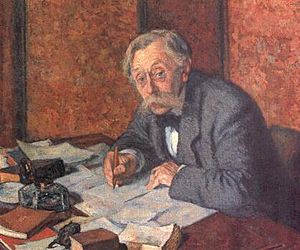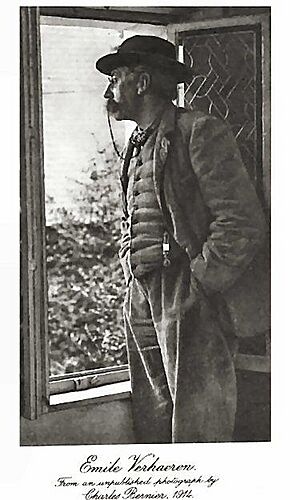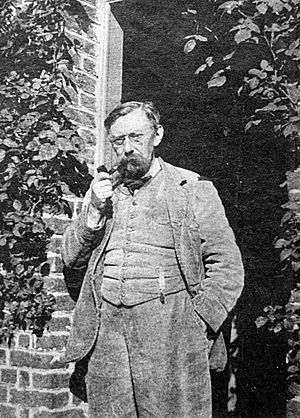Émile Verhaeren facts for kids
Quick facts for kids
Émile Verhaeren
|
|
|---|---|

Portrait of Verhaeren by Théo van Rysselberghe
|
|
| Born | 21 May 1855 |
| Died | 27 November 1916 (aged 61) |
| Nationality | Belgian |
| Education | College of Saint Barbara, Ghent |
| Alma mater | Catholic University of Louvain |
| Occupation | Poet, writer, art critic |
| Known for | Symbolism |
|
Notable work
|
Les villes tentaculaires, 1895 |
| Signature | |
 |
|
Émile Adolphe Gustave Verhaeren (born May 21, 1855 – died November 27, 1916) was a Belgian poet and art critic. He wrote in the French language. He helped start a style of art and writing called Symbolism. He was also nominated for the Nobel Prize in Literature six times.
Contents
Early Life and Education
Émile Verhaeren was born into a middle-class family in Sint-Amands, a small town in Belgium. Even though people in his area spoke a Dutch dialect, he learned French. This was common for important Belgian families at that time.
When he was eleven, he went to a strict boarding school in Ghent. There, he became friends with Georges Rodenbach. Later, he studied law at the University of Leuven. While studying, he started writing for a student newspaper called La Semaine (The Week). He even helped edit it with a singer named Ernest van Dyck. This newspaper, and another one he worked on, were closed down by the authorities. Later, he worked with friends on a new and exciting art magazine called La Jeune Belgique (Young Belgium).
After getting his law degree, he worked with Edmond Picard from 1881 to 1884. Picard was a famous lawyer and an important person in the art world of Brussels. Verhaeren met many young, creative writers and artists during this time when art was changing. He only worked on two court cases before deciding to become a full-time poet and writer.
Art Criticism and Influence
Verhaeren soon became an important voice for new art at the end of the 1800s. He loved the paintings by a group of artists called "Les XX". He wrote many articles in magazines like La Jeune Belgique and L'Art Moderne. In these articles, he gave strong opinions about the art and literature in Brussels.
He especially supported Impressionist painters. His articles helped bring many promising young artists, like James Ensor and Fernand Khnopff, to public attention.
Through his writing, he became a lifelong friend of the Belgian painter Théo van Rysselberghe. They wrote many letters to each other. In one letter, Maria van Rysselberghe described Émile as "a unique person, a whirlwind with a strong spirit, who didn't care about normal rules and who surprised everyone with his directness."
His Writings and Poems
Émile Verhaeren wrote many poems during his life. His first collection of poems, Les Flamandes, came out in 1883. He was inspired by the paintings of artists like Jacob Jordaens and Jan Steen. In his poems, Verhaeren described his country and the Flemish people in a direct and sometimes shocking way. It was an instant hit with new artists but caused a lot of discussion among Catholic groups.
His next book, Les Moines (1886), was not as successful. This, along with some health problems, led to a difficult time for him. During this period, he published Les Soirs (1888), Les Débâcles (1888), and Les Flambeaux noirs (1891).

On August 24, 1891, he married Marthe Massin, who was a talented artist from Liège. His new happiness showed in three poetry books: Les Heures Claires (1896), Les Heures d'Après-midi (1905), and Les Heures du Soir (1911). Some of his later poems include Les Rythmes souverains (1910) and Les Plaines (1911).
He wrote his first play, Les Aubes, in 1898. In this play, he wrote about fighting social unfairness and the decline of life in the countryside. In 1912, he wrote a tragedy called Hélène de Sparte. This play was performed in German and Russian, as well as French.
In 1898, he moved to Saint-Cloud, near Paris. By the early 1900s, he was famous around the world. His works were translated into more than twenty languages. Stefan Zweig was his German translator. He traveled all over Europe, giving lectures.
Verhaeren believed in anarchism, which is a political idea about freedom and no government. When World War I started, it deeply upset him because he believed in peace. He went to England, where he received special degrees from different universities. While he was away from his home country, he published Les Ailes rouges de la Guerre (The Red Wings of War).
Death and Legacy
Émile Verhaeren died on November 27, 1916. He was at the Rouen train station in France. He fell under a moving train while trying to get on it.
His hometown of Sint-Amands has a museum dedicated to him. It shows many of his original writings and letters. It also displays works by his artist friends like Théo van Rysselberghe and Paul Signac. Verhaeren was the cousin of the painter Alfred Verhaeren.
Honours
- 1920: He was given the Grand Cordon of the Order of Leopold after his death.
Main Works
- Les Flamandes, 1883
- Les moines, 1886
- Les soirs, 1888
- Les débâcles, 1888
- Les flambeaux noirs, 1891
- Les campagnes hallucinées, 1893
- Les villes tentaculaires, 1895
- Les heures claires, 1896
- Les ailes rouges de la guerre, 1916
See also
 In Spanish: Émile Verhaeren para niños
In Spanish: Émile Verhaeren para niños


